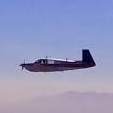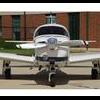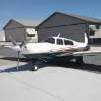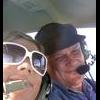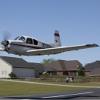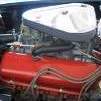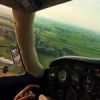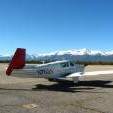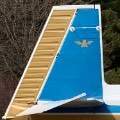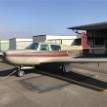Leaderboard
Popular Content
Showing content with the highest reputation on 06/17/2025 in all areas
-
Isn't oil pressure affected by RPM, and to a lesser extent temperature? Throttle back to me sounds like @FredG is leaving the blue knob at the cruise setting. With my IO-360A3B6D, I do notice a reduction in oil pressure down to about 60psi when I pull the RPM back (either with the blue knob or by dropping MP so much the prop falls out of governing range), but I do not notice a difference by changing MP alone. By the way, the oil pressure is easily adjustable: 60297-12[1].pdf (Page 109 - Oil Pressure Relief Valve)2 points
-
On my J, I would get some fluctuation in oil pressure, and would show up first in a decent when the oil level was below 5.75 quarts or so. As long as it was more than 6 quarts, there was no change. I never did figure it out and simply kept the oil level between 6-7 quarts. A couple of theories were tossed around and the one I most believed in was a leak on the inside of the oil pickup between the case and the pan. The idea was when there was more than 6 quarts, that joint was below the oil level and therefore couldn't suck any air. The oil pickup is on the back of the engine so when nose down, that joint would get exposed earlier.2 points
-
2 points
-
Look at it this way…if it’s burning a quart every 18 hrs, it’s at least burning oil! Welcome to oil consumption Stockholm syndrome. You’re blessed, just run with it!2 points
-
A G5 is a very good instrument and a good addition if you have a GPS navigator. My G5 HSI was installed not long after my DG failed, and later after several AI failures I punted and put in a second G5 to replace the AI. I highly recommend them. I've flown with GI-275s as well, and while they certainly have their place, I think the display space on the G5 is used much more efficiently and is more readable than the 275. I'd suggest getting a good look at both before making a decision.2 points
-
I am selling my M20C turbo kit l purchased about 6 years ago from a freind of Rayjay Tom. It includes all the parts and at the same time of purchase bought the exhaust gaskets and a scavenger pump kit, which Tom said it needed. A whole book on installation instructions to manual etc ... It has a separate throttle which controls the turbo, meaning you can use the turbo only when you need it. J never got the chance to install it. now lm changing to a different aircraft. includes exhaust $12,0001 point
-
The all women's Air Race Classic starts today... though there are apparently Wx delays and the first stop of the race has been eliminated due to Wx. Routing for our home town team, the Sky Queens, who happen to be out of SFF, the final destination airport of the race. Also of note, they did a video of most of the planes lined up in team order. There were a number of Mooneys in there.... Let's see how the handicapping works out.1 point
-
If you have maintenance records back a full year, AD history, STC paperwork, etc., basically everything that is actually required by the regs, then you aren't missing anything. The only place where "missing records" creates an issue is with a buyer using it to try to negotiate a reduced price from a seller. It is strictly a percieved value issue. If you have the records required by regulation, everything else is just used for negotiation, so do with it what you will. As already mentioned, that page may have been taken out due to a coffee spill or whatever other reason. If you're basing all of this on input from your current A&P, you're only hearing one side of the story. You'd probably hear something completely different from the other A&P. Don't get caught in the middle or to one side. This can happen to a new aircraft owner and it can wind up being very expensive if you don't take your time, proceed slowly, and get additional opinions. GA airplane alternators are often based on automotive alternators (if not direct appropriations) and if the installation on your airplane is an STC it is possible that you have the correct alternator. As you were previously advised, look at any relevant STCs before making too many conclusions.1 point
-
I feel for you, but from what you have described, this is going to be an expensive lesson, I'm afraid. I'm definitely NOT a lawyer but I'm not seeing anything here that you are going to be able to prove. You will spend a FORTUNE on an investigation and lawyers with very little chance of ever obtaining satisfactory compensation. No, the logs aren't 'complete' but it's going to be near impossible to put a value on them. The older the plane the less it's going to matter. Not having engine records BEFORE an overhaul wouldn't matter much to me, anyway. But that's just me. This was a 'buyer beware'/as-is sale as far as I can see.1 point
-
Regarding log book, it is possible that there was nothing on missing pages or it was an error. I have seen logs….have some for one of my own plane, where pages are crossed out because they were intended for the engine log and were entered in error. I can imagine e a situation where they tore out the error not thinking it would look bad. As someone suggested, what is on the adjacent pages? Is there a logical gap in history. I won’t speak to the legal, but these threads usually trend bad for the poster….just a consideration early in the thread.1 point
-
I hated my old PTT button that was Velcro strapped to the horizon section of my yoke. The button was starting to stick on, and I was starting to get in the habit of having to pull the button out after every transmission. I finally had enough of that, now I have to get used to barely touching the button. Absolutely love my new PTT button, thanks for attaching the file to your thread.1 point
-
What are the dates on the surrounding pages? Records older than a year are not required to be kept. There is no regulatory requirement to keep maintenance records older than one year. Records are also not required to be kept in "logbooks" or even in paper or whatever. The records that are required are just required to be kept as records. They can be written on used napkins as far as the regs are concerned. If the record was older than a year I don't know what basis you'd have for pursuing action against anyone.1 point
-
Problem solved it was a misunderstanding and LASAR is the best the key is $35.1 point
-
I did a search on my old posts and found the Turboplus instructions for setting fuel flow:TSIO360 Fuel Setup - NEW 08.pdf As I said earlier, some of us try to get the fuel flow set a little higher. Please note that the max power MP in these instructions will generally be higher than the 36-37" most of us use to set full power in flight. The fuel setting process is conducted on the ground with the aircraft not moving and therefore very little air is passing over the intercooler to cool the induction air. The intercooler becomes more efficient as the aircraft picks up speed during takeoff and flight, and air passes through the scoop and over the fins of the intercooler. At cruise at altitude it is not uncommon to see a differential temperature (Compressor Discharge Temperature minus Induction Air Temp) of 100-125 degrees. So the higher max power MP in the table in the instructions is not directly applicable to in-flight power settings.1 point
-
When my O360-A1D ate its cam/lifters and went in for overhaul last August, it had been consuming 1qt/3 hrs for a couple of years. That seemed too high to me, and I was worried - it was likely all lost out the breather due to blowby, given the oil turned black just a few hours after oil change. I've had the engine/plane back for >6 months now. After 20-25 hrs breakin with mineral oil, I changed to Phillips XC 20W50 w/ Camguard and flew the hell out of it. I just did the next oil change after another 46 hours. No more black oil. During that interval, I calculate using 1qt every 18 hours. That seems too low to me, and I am again worried Does my freshly overhauled engine with new Superior cylinders have a cylinder lubrication problem?? The engine notably cools much better now with a new carb and refreshed baffling. However, worrying about my engine remains one of my favorite pastimes. I will likely be back in a few years posting concern over my average levels of oil consumption.1 point
-
So, when I submitted my request I ALSO asked for my personal information to be removed from the FAA Pilot Registry, and as of today, my name and information does NOT shoe up when entering registration number or pilot name in the Pilot Registry database...PROGRESS1 point
-
I just tried that today on my Garmin G5 and it worked. Thanks Lance, that’s really helpful and I didn’t know that before!1 point
-
Mine would never stay open and would hit me in the back all the time. My IA didn't have a problem with me putting a small gas strut on it. It holds the door open great, when taxiing or doing runup the prop wash closes it to about 2 inches and then opens back up smoothly at idle. After my baggage door arm got bent terribly by a mechanic I put a small gas strut on that as well. It's nice because as it closes it goes over center and applies pressure to keeping the door shut. Not sure if it would make a difference if the baggage door wasn't latched and not will to try that experiment... They're similar to this but I would have to look at the length and weight rating to see what I have on there, I ordered a few different ones before settling on which worked best.1 point
-
I have specific experience with this. We did exactly what you're proposing, about 4 years ago: installed a single G5 configured as an ADI to replace our failing vacuum AI. We retained our vacuum system to drive the vacuum DG and the Brittain autopilot. The ADI installation is relatively simple compared to an HSI installation, and any A&P can likely do it competently. All you need is the G5 itself, a connector kit, and pneumatic couplings for the pitot/static lines (collectively the cost of all this is a bit more than the G5 unit by itself, but not much). No integration with nav radios is required, though you do have to either connect to the RS-232 GPS output from a GPS, or connect an external antenna to the GPS receiver in the G5 itself. Any competent shop will have done a bunch of G5 installations, and should be able to give you reliable quotes for various options with reasonable labor charges. Make sure any quotes you get include the connector kits, so as not to be surprised by a small-but-non-zero additional charges over what you might see vs. online advertised prices for the G5 unit alone. One thing to be aware of is that if you have a standard 6-pack panel with the DG directly below the AI, and you do not pay extra for the equipment and labor to flush mount the G5 ADI, the outer bezel of the G5 unit may impinge on your view of the very top of the DG. The very top of the DG is of course the most important part, so that's a concern. I didn't think this would be a big deal, but it did moderately annoy me for a year or so until we bit the bullet and installed a second G5 as an HSI. Whether you'll have this problem depends on the particulars of your panel, seat position, and height. You should make yourself a little mock-up of the outer bezel of the G5 to see how things would look in your airplane. I disagree that a GI-275 is a no-brainer preference over the G5, though it's a complicated decision. I've flown both, and yes, for about $2K more the GI-275 has more features, a higher resolution display, and it won't have the non-flush-mount problem I discuss above with the G5. It's a wonderful instrument. But it's also a physically smaller instrument, despite its higher display resolution. So if you really take advantage of all the extra EFIS features (synthetic vision, airspeed and altitude tapes, VSI indications, GPS track, flight path marker, slip/skid indicator), you wind up with a very busy display on a very small screen. This would have been fine with me in my 20s and 30s when my eyes were great. Now that I require optical assistance, I prefer simpler and larger displays, and to some degree a GI-275 ADI feels more like a win in the bragging rights department than it does in actual utility. The display can be simplified by disabling features, but then you of course wind up asking yourself why you paid more for them in the first place. So... it's a big cost/benefit personal preference issue, and you shouldn't choose something on the basis of pictures on the internet or what others argue here. Make the effort to go see some actual installations in actual airplanes, ideally in a Mooney similar to yours. Finally, consider how likely you are to install a second electronic gizmo when your vacuum DG/HSI eventually fails. HSI installations are complicated by interfaces to magnetometers, radios, and autopilots, and the GI-275 has some advantages in that department due to native interfaces it supports, which require an extra converter box (GAD29) in a G5 installation. Those advantages mitigate some of the additional cost of the GI-275 unit itself vs. a G5. Hard to say how much without a specific quote, so you might want to get quotes on dual ADI/HSI installations even if you intend to retain your vacuum-powered DG/HSI for now, just to understand the future cost implications.1 point
-
My minimums are not a single number. I don’t say, for example, “I won’t fly a precision approach below X feet and Y visibility.” I try to assess flight risk based on a wide range of factors. The FRAT — Flight Risk Assessment Tool — app available for free on the Apple Store is an example of how a number of factors and their interactions are evaluated in concert to estimate the risk of a proposed flight.1 point
-
My request was also successful. HOWEVER, somehow this database https://www.aviationdb.com/Aviation/AircraftQuery.shtm, which presumably uses the FAA database, still has all of my personal info displayed. Maybe it will eventually time out?1 point
-
I have posted this before but it's worth repeating. On any 262 14 V TSIO 360 MB engine of any version do not use a lightweight starter. Use the original big heavy one. My '84 262 airplanes lightweight starter activated during a flight, destroyed some gears in the accessory case and caused a simultaneous electrical and vacuum failure. I talked with TCM about this event and they related that there have been a half dozen reported similar occurrences in a Mooney 262 using a lightweight starter.1 point
-
1 point
-
I have learned from this forum that Mooney’s are so spacious compared to other planes that you could comfortably put two circus elephants in the front seats. Enjoy!1 point
-
Flaps should be totally hydrolocked after four pumps. More than that and there is air in the system. I made a short video so folks have a reference for how they should perform when properly set up.1 point
-
What causes the back plate and dog ears to crack is the interference fit on the ring inside the spinner is too sloppy with the hub. It also helps to snug the ears to the back plate and spinner prior to tightening so as to not induce a slight misalignment load. Yea, I bought a new back plate and a couple of ears (they always break at the narrow part) until I figured out the cause. It also doesnt hurt to take a little emery paper and knock the sharp edge off the dog ears to help mitigate the development of a crack.1 point

